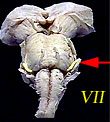Neuroscience For Kids
Bell's Palsy
By Kate DiNucci, Neuroscience for Kids Guest Writer
April 18, 2023
Weakness or loss of function of one side of the face is often a cause for concern because many people think it is a symptom of a stroke. Several conditions can cause weakness of one side of the face, including a brain tumor, myasthenia gravis, and Lyme disease. However, the most common cause of facial paralysis or weakness is Bell's palsy.
What is Bell's Palsy?
 Bell's palsy is a neurological disorder caused by a dysfunction of
the facial nerve (cranial nerve VII) that results in paralysis or
weakness on one side of the face. The facial nerve connects your brain
to the muscles in your face and controls facial movement and expression.
Bell's palsy is also known as facial palsy, idiopathic peripheral
facial palsy, or cranial mononeuropathy.
Bell's palsy is a neurological disorder caused by a dysfunction of
the facial nerve (cranial nerve VII) that results in paralysis or
weakness on one side of the face. The facial nerve connects your brain
to the muscles in your face and controls facial movement and expression.
Bell's palsy is also known as facial palsy, idiopathic peripheral
facial palsy, or cranial mononeuropathy.
Symptoms of Bell's Palsy
Bell's palsy commonly presents as a sudden weakness or paralysis on one side of the face within a 48 to 72 hour period of the first symptoms. People with Bell's palsy may have trouble smiling or closing their eye on the affected side. Other symptoms may include increased sensitivity to sound on the affected side, headache, pain around the jaw or behind the ear, or loss of taste. Sometimes these symptoms may result in facial pain, excessive tears or saliva, or trouble eating and drinking. Symptoms may improve without treatment within a few weeks, with a full recovery typically in six months.
Who gets Bell's Palsy?

In the United States, approximately 40,000 people are affected by Bell's palsy each year. The incidence of Bell's palsy is about the same in men and women and the most common age for people to get Bell's palsy is between 15 to 45 years old. Common risk factors include pregnancy, preeclampsia, obesity, hypertension, and diabetes. Although the exact cause of Bell's palsy is unknown, research has suggested an association between the condition and viral infections such as Lyme disease, sarcoidosis, chickenpox and shingles, infectious mononucleosis, herpes (both HSV-1 and HSV-2), HIV/AIDS, cytomegalovirus infections, mumps, the flu, and hand-foot-and-mouth disease. Therefore, impaired immunity, for example from stress, sleep deprivation, physical trauma, illness, or autoimmune syndrome, may put people at higher risk for Bell's palsy.
How is Bell's Palsy diagnosed?
Because the exact cause of Bell's palsy is unknown, diagnosing the disorder is usually made by a clinical examination while ruling out other causes of facial weakness or paralysis. During a clinical examination, a doctor will examine a person's facial muscles to determine the extent of the weakness. Other tests used to diagnose Bell's palsy:

- Electromyography (EMG): electrodes are placed into a muscle to assess nerve damage
- Blood tests: To detect possible infection
- Diagnostic imaging: magnetic resonance imaging (MRI) or computed tomography (CT) to determine if there are anatomical abnormalities causing the symptoms.
Treating Bell's Palsy
Bell's palsy often resolves on its own over time, however various treatments may be used to speed up recovery. Steroids help reduce inflammation and swelling of the facial nerve, antiviral agents can help restore facial movement, analgesics (e.g., Aspirin or ibuprofen) can relieve pain, and eye drops can be used if there is difficulty closing the affected eye. Physical therapy, facial massage, or acupuncture may relieve symptoms in some people. In extreme cases, cosmetic or reconstructive surgery can correct pervasive facial paralysis.
Preventing Bell's Palsy
Because there is no known cause of Bell's palsy, there is no way to definitively prevent the disorder. A healthy lifestyle including a balanced diet, exercise, and seeking proper medical treatment for viral infections to help keep the immune system strong are all ways to keep the body in top shape.
References:
- National Institute of Neurological Disorders and Stroke - Bell's Palsy
- Mayo Clinic - Bell's Palsy
- Penn Medicine - What is Bell's Palsy
Copyright © 1996-2023, Eric H. Chudler All Rights Reserved.